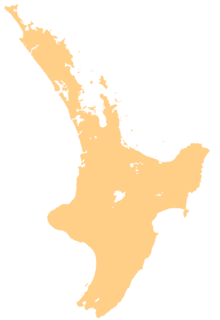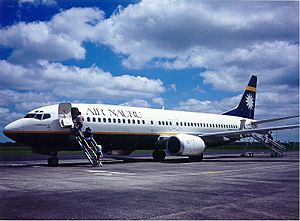Hamilton Airport (New Zealand) facts for kids
Quick facts for kids
Hamilton Airport
|
|||||||||||||||||||
|---|---|---|---|---|---|---|---|---|---|---|---|---|---|---|---|---|---|---|---|
| Summary | |||||||||||||||||||
| Airport type | Public | ||||||||||||||||||
| Operator | Hamilton Airport | ||||||||||||||||||
| Location | Waipa District | ||||||||||||||||||
| Elevation AMSL | 52 m / 172 ft | ||||||||||||||||||
| Coordinates | 37°52′0″S 175°19′55″E / 37.86667°S 175.33194°E | ||||||||||||||||||
| Website | http://www.hamiltonairport.co.nz | ||||||||||||||||||
| Map | |||||||||||||||||||
| Runway | |||||||||||||||||||
|
|||||||||||||||||||
Hamilton Airport (HLZ/NZHN) is a busy airport in New Zealand. It is located about 14 kilometers south of Hamilton city in the Waikato region. The airport is built on land called Rukuhia. This was once a base for the Royal New Zealand Air Force during World War II.
Contents
How Many People Fly From Hamilton Airport?
Hamilton Airport is one of the busiest airports in New Zealand. In the year ending June 30, 2011, about 316,000 people flew on domestic flights. Another 46,000 passengers took international flights.
By 2017/2018, the airport served 353,000 passengers. All of these were domestic flights. Most people flew to Wellington (54%) or Christchurch (37%). Hamilton is the eleventh-busiest airport in New Zealand based on how many passengers it handles.
The Story of Hamilton Airport
The land where Hamilton Airport now stands was owned by Samuel Steele around 1880. By 1929, there was already a small landing area on his farm. In 1935, Steele's aerodrome was sold. It was then expanded into a proper airport and officially opened by the mayor on October 12.
Hamilton Airport During World War II
As the world prepared for World War II, it became clear that a landing strip was needed near Hamilton. The airstrip was already in use by 1935. It served as a stop for military aircraft on long journeys. The base provided fuel, food, and rest for pilots.
Growth of Commercial Flights
Air travel became very popular after the war. In 1950, Hamilton Airport welcomed its first commercial flight. The main runway was paved in 1965. That same year, turboprop planes like NAC's Fokker Friendship began flying to Hamilton.
The runway was made even longer in 1970 to fit Vickers Viscount planes. By 1975, it was long enough for Boeing 737 aircraft.
New Ownership and Expansion
In 1989, the New Zealand government sold the airport. It was bought by several local councils. These included Hamilton City (50%), Waikato District (15.625%), Waipa District (15.625%), Matamata-Piako District (15.625%), and Ōtorohanga District (3.125%). This change helped the airport grow a lot.
Ansett New Zealand built its own passenger terminal at the airport. It had a special lounge and food machines. Ansett NZ flew from Hamilton to Wellington from 1995 to 2000. Then, the airline was sold and became Qantas NZ. Qantas NZ operated at the airport until 2001. After that, Origin Pacific airlines used the terminal until they also stopped flying in 2006. The small terminal was then left empty.
In 1998, the Hamilton Airport Motor Inn was built. This hotel provided a place for travelers to stay near the airport.
A big upgrade to the terminal began in 2005. It cost NZ$15.3 million. The terminal became 60% larger. It had better areas for handling luggage, improved check-in spaces for international and domestic flights, and better security screening. This expansion was finished in late 2007.
Flights Across the Tasman Sea
In 1994, Hamilton Airport started offering flights across the Tasman Sea to Australia. Kiwi Travel International Airlines used Boeing 727 planes to fly to Brisbane, Sydney, and Melbourne. Kiwi went out of business in 1996. However, Freedom Air soon started flying the same routes with Boeing 737 aircraft. They even flew to Nadi, Fiji, for a short time in 2005.
Freedom Air made Hamilton International Airport its main base. But its parent company, Air New Zealand, closed Freedom Air in 2008. Air New Zealand then started its own full service from Hamilton using Airbus A320 planes.
However, the number of passengers flying to Australia dropped. So, Air New Zealand stopped these flights in August 2009. Virgin Australia tried to offer flights to Brisbane later that year. They used Boeing 737-800 planes twice a week. But passenger numbers stayed low. Virgin Australia ended its flights on October 27, 2012. Since then, there have been no international flights from Hamilton Airport.
Learning to Fly at Hamilton Airport
Hamilton Airport was once home to the New Zealand Training Centre of L3Harris Airline Academy. This academy trained airline pilots for many airlines around the world. They trained pilots for airlines like EasyJet, British Airways, and Qatar Airways.
Most of the non-passenger flights at the airport were from L3Harris training. They used small planes like the single-engine Diamond DA20 and Cessna 172, and the twin-engine Diamond DA42 Twin Star. The school closed in February 2021. The company said the COVID-19 pandemic was one reason for the closure.
The Waikato Aero Club has been at Hamilton Airport since 1933. This club teaches people how to fly. They offer training from fun recreational flying to advanced commercial pilot courses.
What Kind of Planes Can Hamilton Airport Handle?
Hamilton Airport can handle many different types of aircraft. These range from small planes with piston engines to larger commercial turboprop planes like the ATR 72. The airport can also handle all light business jets. It can even manage regional jets with 40 to 80 seats, such as the Embraer E195 and Bombardier CRJ200.
Several larger airliners can also use the airport. These include the 100 to 200-seat Boeing 737, Boeing 757, and Airbus A320. The biggest plane allowed to land at Hamilton is the 150 to 250-seat Boeing 767. There have been talks about making the runway longer, from 2,195 meters to 3,000 meters. This would allow even larger planes to land and start flights to Asian regions.
The airport operates 24 hours a day, seven days a week.
In August 2011, Hamilton International Airport received approval to extend its runway to 3,000 meters. This is the same size as secondary airports in other parts of the world, like the Gold Coast in Australia. The extension will be completed before the 15-year approval period ends.
The airport has one terminal building and six gates where planes can park. The area where planes park (the apron) can hold up to five A320 or 737-800 aircraft at the same time.
Airlines and Where They Fly
Here are the airlines that fly from Hamilton Airport and their destinations:
| Airlines | Destinations |
|---|---|
| Air New Zealand | Christchurch, Wellington |
| Originair | Nelson, Palmerston North |
| Sunair | Claris, Gisborne, North Shore, Whangarei |
See also
 In Spanish: Aeropuerto de Hamilton (Nueva Zelanda) para niños
In Spanish: Aeropuerto de Hamilton (Nueva Zelanda) para niños





